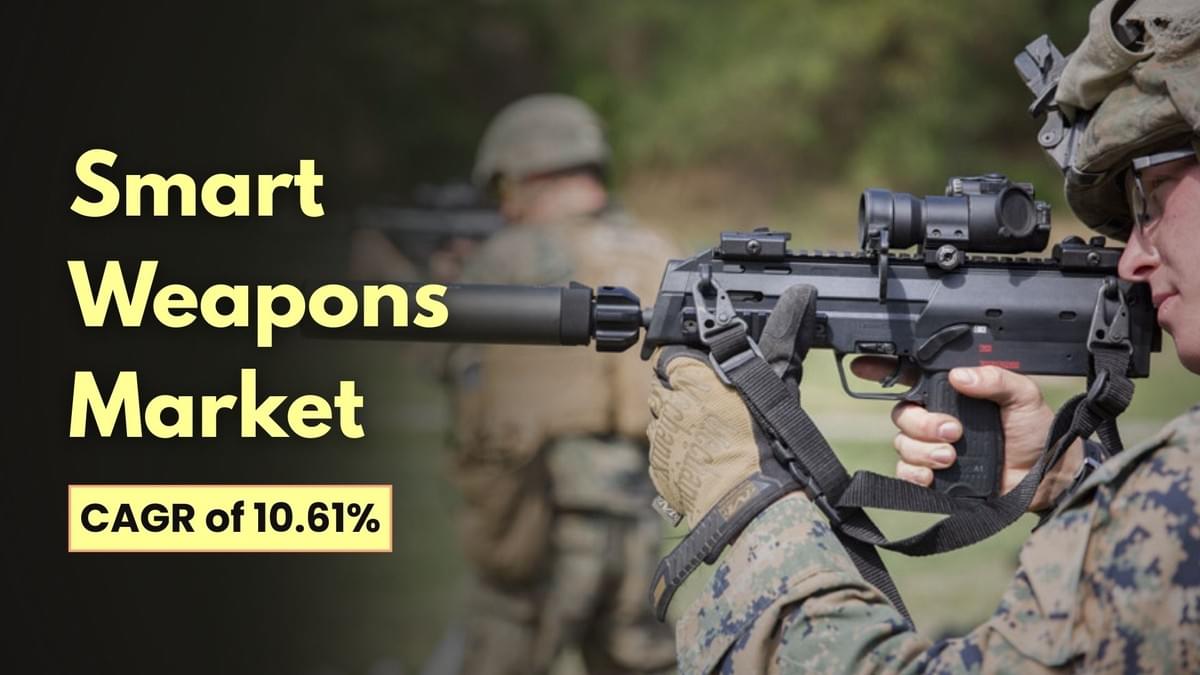According to Fortune Business Insights™, the global smart weapons market was valued at USD 18.99 billion in 2023 and is projected to expand from USD 20.20 billion in 2024 to USD 45.24 billion by 2032, at a CAGR of 10.61% during the forecast period. This robust growth is fueled by rising global defense budgets, large-scale military modernization programs, and increasing demand for precision strike capabilities in evolving combat environments.
Market Overview
The global defense industry is undergoing rapid transformation amid escalating geopolitical tensions, cross-border disputes, and asymmetric warfare challenges. To strengthen combat effectiveness while minimizing collateral damage, militaries worldwide are integrating advanced smart weapons systems into their arsenals.
Smart weapons—including sensor-fused munitions, guided bombs, cruise missiles, and satellite/laser-guided systems—offer superior precision, extended range, and greater operational flexibility compared to conventional weapons. Their deployment enhances mission success rates and supports modern doctrines emphasizing targeted, low-risk engagements.
In 2023, North America accounted for 33.86% of the global market, driven by high U.S. defense expenditure and the presence of leading defense contractors such as Lockheed Martin, Northrop Grumman, and Raytheon Technologies.

Key Market Players
- Lockheed Martin Corporation (U.S.)
- Raytheon Technologies (U.S.)
- Northrop Grumman Corporation (U.S.)
- General Dynamics Corporation (U.S.)
- Boeing (U.S.)
- Textron Inc. (U.S.)
- BAE Systems (U.K.)
- Thales Group (France)
- MBDA (France)
- Rheinmetall AG (Germany)
- Others
Information Source:
https://www.fortunebusinessinsights.com/smart-weapons-market-104058
Market Segmentation
By Product:
- Missiles & Munitions – Dominant segments owing to proven effectiveness, precision, and multi-platform deployment.
- Guided Projectiles & Rockets – Gaining adoption for cost-effective accuracy in tactical missions.
- Directed Energy Weapons (DEWs) – Emerging segment with potential to revolutionize warfare through speed, precision, and low-cost per shot.
By Platform:
- Land Systems – Expected strong growth due to investments in border security, counter-terrorism, and modernization of ground-based defenses.
- Air Systems – Increasing integration of precision weapons into fighter jets, UAVs, and helicopters.
- Naval Systems – Deployment of smart torpedoes and anti-ship missiles enhancing maritime strike capabilities.
By Technology:
- Laser & Satellite Guidance – Leading technologies ensuring superior targeting precision in both urban and open-terrain operations.
- Infrared & Radar Guidance – Vital for low-visibility and electronic warfare conditions.
- Others – Emerging solutions leveraging AI, autonomy, and advanced sensors for improved battlefield awareness.
Regional Insights
North America – Valued at USD 6.43 billion in 2023, the region maintains dominance due to high defense budgets, advanced R&D programs, and a strong presence of OEMs such as Lockheed Martin, General Dynamics, and Northrop Grumman. The U.S. Department of Defense continues to drive procurement of next-generation smart weapons, supported by partnerships with domestic suppliers and international allies. Additionally, Canada is investing in modernization programs to align with NATO commitments.
Asia-Pacific – Identified as the fastest-growing region, fueled by military modernization initiatives in China, India, South Korea, and Japan amid escalating territorial disputes in the South China Sea and along the Indo-Pak border. China continues to expand its indigenous smart weapons development, while India’s “Make in India” defense push is encouraging domestic production alongside foreign collaborations. South Korea and Japan are accelerating investments in missile defense and precision strike capabilities to counter regional threats.
Europe – Growth is underpinned by leading players such as BAE Systems, Thales, and Rheinmetall, alongside increased defense spending in the U.K., France, Germany, and Russia. The Russia-Ukraine war has significantly accelerated demand for smart munitions and modernized weapons systems across NATO states. EU defense cooperation initiatives, including the Permanent Structured Cooperation (PESCO) projects, are further supporting innovation and procurement of advanced weaponry.
Rest of the World – Middle Eastern countries, including the UAE, Saudi Arabia, and Israel, are investing heavily in smart weapons to strengthen deterrence capabilities. For example, in 2019, EDGE Group won a USD 1 billion contract to supply Desert Sting-16 guided munitions. Saudi Arabia is expanding its domestic defense manufacturing under Vision 2030, while Israel remains a global leader in smart weapons exports. In Latin America, Brazil is gradually increasing defense budgets with a focus on modernization, while African nations are beginning to adopt precision-guided systems, though at a smaller scale compared to other regions.
Market Dynamics
Growth Drivers:
- Rising Demand for Precision Weapons: Essential for minimizing collateral damage and maximizing mission success.
- Increasing Defense Expenditure: SIPRI reports highlight significant investments by the U.S., China, India, Russia, and Saudi Arabia.
- Technological Advancements: AI integration, autonomous targeting, and advanced navigation systems improving accuracy.
- Strategic Defense Contracts: Long-term deals with defense departments strengthening industry outlook.
Restraints:
- Stringent Export Regulations: Policies in countries such as India, Australia, and the U.K. limiting market expansion.
- Pandemic Disruptions: COVID-19 caused temporary production halts and delivery delays (e.g., Rafale production suspension in France, 2020).
Key Industry Developments
- February 2021: Lockheed Martin secured a USD 414 million contract with the U.S. Navy and Air Force for Long-Range Anti-Ship Missiles (LRASM), enhancing maritime strike capabilities.
- March 2020: Raytheon Technologies awarded an USD 86 million DoD contract to provide engineering services for the M982 Excalibur, a long-range precision artillery system.
No responses yet